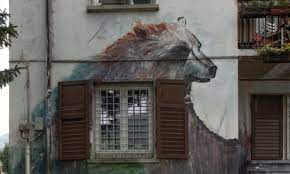Italy: Governor steps up his battle against bears in Trentino region

Rome: For several weeks, Italians have been following with bated breath the escalation of Maurizio Fugatti’s battle against the bears that populate the mountains of the northern Trentino region of which he is governor.
Captures, imprisonments, deportations and death sentences have followed one another to the chagrin of national public opinion and government inertia. In Trentino, there have been demonstrations for and against the bears.
It comes after the Giorgia Meloni government, in which far-right parties including Fugatti’s League form the largest part of the coalition, began hacking away at hunting regulations when it took office – loosening laws to allow the capture and culling of wild animals in urban areas – and Trentino avoids full compliance with Italian wildlife laws. The Council of Europe’s Berne convention and the EU’s habitats directive to protect plant and animal species also appear to be being ignored.

Anxieties centre on the fate of the bear JJ4, which will be decided on 25 May by the ruling of the Trento regional administrative court. Following appeals by national and international animal welfare groups the court has already rejected two of Fugatti’s requests to kill the animal, the first after the bear attacked and injured two hikers.
An incident on 5 April began the current episode when Andrea Papi, a 26-year-old runner, was found dead in the woods with wounds to his neck, arms and chest that an autopsy attributed to a bear. It is assumed that he encountered a bear cub and that its mother (named JJ4, from her parents’ initials, Joze and Jurka) mistook him for a threat. Campaigners say JJ4, already on Fugatti’s blacklist, was not responsible.
Fugatti has declared he would have JJ4 killed “tomorrow, if only they would let me”, and called for the removal of a further 70 “excess” specimens to other regions.
Papi’s parents have publicly declared they oppose retaliation against JJ4, saying that “killing the bear will not give us back our son”. Rather, they point to the poor management of the EU Life Ursus repopulation project through which, in the mid-1990s, the region’s administrators and the Adamello Brenta nature park decided to repopulate the area with bears by taking advantage of EU funds. A survey found more than 70% of the local population at the time were in favour of their reintroduction.
Bear rewilding in Trentino, Italy – in pictures
“We have offered to transfer JJ4 and the bears already captured, or on whom specific capture and killing orders have been issued, to international locations that would ensure their welfare,” said Gianluca Felicetti, the president of the animal rights association LAV. “But Fugatti is opposed.”
Ivana Sandri, an ethologist and representative of the animal welfare group ENPA in Trentino, said: “Bears cannot be punished because they behave like bears, mothers because they defend their cubs. Is there still a space we are willing to give wild animals, where we try to understand their needs, and not vice versa?”
The Life Ursus project – which captured bears in Slovenia for release in Trentino – called for projects to promote a peaceful coexistence with humans, and the creation of an emergency team capable of dissuading or transferring certain individuals. Culling was also contemplated, but only once other deterrents had been tried and failed.
The reintroduction has brought benefits to the region – one recent report said television coverage of the bears had been worth €2.6m (£2.25m) while bear images are widely used, from the logo (recently modified) of the local public transport company, to the packaging of one of Trentino’s most important wineries, Cantine Ferrari.
But work on coexistence was omitted and since the mid-2000s bears have paid the price for human failures, starting with the lack of agreements with neighbouring countries.
In early summer 2006, when Germany was hosting the football World Cup, ultimately won by Italy, the young bear JJ1 crossed from Trentino into Austria and then Bavaria. He was renamed Bruno and shot despite Italian pleas to save him. JJ1 was stuffed and displayed in Nymphenburg Palace in Munich.
In 2008, his brother JJ3 was killed in Switzerland, where in 2005 JJ2 had also been spotted and disappeared without trace. The mother, Jurka, was recaptured in Trentino in August 2006 and sterilised and initially kept in a dark pit under the medieval sanctuary of San Romedio, near Sanzeno, where in an ancient legend a bear was kept in captivity. Her three cubs were left to fend for themselves in the wild.
Only one probably survived: JJ4, who is separated from her three cubs, exactly the same way as her mother was.
Jurka was then transferred to Casteller, the fortress where the province of Trento imprisons bears accused of being aggressive. It was only in 2010, after a long battle, that a transfer was obtained for her to a small German zoo, the Alternativer Wolf- und Bärenpark Schwarzwald.
In central Italy, in Abruzzo national park, the age-old coexistence between humans and bears has been working well but in Trentino the deaths have mounted.
Daniza, a bear with two cubs, was killed by an overdose of tranquillisers in 2014 during her capture, and shortly after F43 was also killed by an overdose. The then-president of the province, Ugo Rossi, a member of the Democratic party, in 2017 defended the killing of KJ2, who reportedly had her cubs with her, after the mauling of an elderly man walking with his dog in an area frequented by bears with cubs.
In office since 2018, Fugatti – who in 2011 took part in the organisation of an illegal bear meat banquet – has promised to his electorate with increasing vehemence to take on the bears before what he hopes will be his re-election in October.
But on the actual number of bears supposedly in Trentino, and on how they are being identified, including their DNA database, the regional government offers no transparency. Someone has even advanced the suspicion that the mysterious escapes of M49, a bear that had supposedly been recaptured several times, have not always involved the same specimen.





